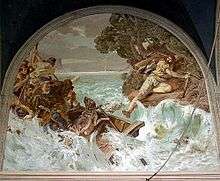Tellskapelle


Coordinates: 46°55′57″N 8°36′42″E / 46.9326°N 8.6118°E The Tellskapelle ("Tell's chapel")[1] is located on the Tellsplatte or Tellenplatte ("Tell's slab") on the shore of Lake Lucerne at the foot of the Axenberg cliffs (an offshoot ridge of Glärnisch, 1,022 m), in the Sisikon municipality, canton of Uri, Switzerland. It is across the Bay of Uri (Urnersee) from the Rütli, some 4.3 km away.
The Catholic chapel[2] marks the site where according to legend, William Tell during a storm leapt from the boat of his captors (the Tellensprung "leap of Tell") and escaped, allowing him to assassinate the tyrant Gessler and initiate the rebellion that led to the foundation of the Old Swiss Confederacy. The Tellenplatte is first mentioned in 1470 in the White Book of Sarnen, as Tellen blatten.
There are traditions of a chapel built on the site as early as 1388, but the earliest reliable mention of the chapel dates to the chronicle of Heinrich Brennwald (1508–16). In 1561, a society was established which held an annual memorial service at the chapel. The chapel was enlarged or rebuilt in 1589 to 1590. In 1599, its altars were dedicated to Saint Sebastian, Saint William, the Holy Trinity, the Blessed Virgin Mary and All Saints. From the 17th century, the annual service and the associated procession were officially sanctioned by the canton of Uri.
The current chapel was built in 1879. It is decorated with four frescos by Ernst Stückelberg, realized in 1880-1882.
| Wikimedia Commons has media related to Tellskapelle. |
References
- ↑ Catholic World. Paulist Fathers. 1875-01-01.
- ↑ New Catholic World. Paulist Press. 1875-01-01.